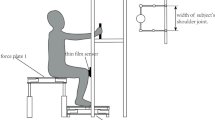Abstract
Different handrail heights and initial foot angles are crucial to the performance of the STS movement. However, to the best of our knowledge, the effects of changing the toe orientation at different handrail heights on lower limb kinematics and dynamics have not yet been investigated. The purpose of this study was to investigate the comprehensive effects of different handrail heights on both sides and different initial foot angles on the kinematics and kinetics of healthy adults during the sit-to-stand movement. This study recruited 16 healthy young individuals, including 8 men and 8 women. The test was performed under seven conditions. The percent of movement time in each phase, the variation range of each joint angle of lower limb, and the joint moment of lower limb were analyzed and compared. There was an interaction between the handrail height and initial foot angle in relation to the percent of movement time in the fourth phase (P = 0.012). The initial foot angle had a significant effect on the variation range of the ankle joint angle (P = 0.016). The handrail height had a significant effect on the variation range of the hip joint angle (P = 0.019). During the sit-to-stand movement, individuals are able to stand and balance more rapidly under toe-middle under a high handrail than under other conditions. Toe-in under a high handrail may be more appropriate for patients with ankle joint injuries. High handrails should be preferred for those whose trunk cannot tilt forward sufficiently when leaving their seat.













Similar content being viewed by others
Explore related subjects
Discover the latest articles, news and stories from top researchers in related subjects.References
Arborelius, U.P., Wretenberg, P., Lindberg, F.: The effects of armrests and high seat heights on lower-limb joint load and muscular activity during sitting and rising. Ergonomics 35(11), 1377–1391 (1992). https://doi.org/10.1080/00140139208967399
Burdett, R.G., Habasevich, R., Pisciotta, J., Simon, S.R.: Biomechanical comparison of rising from two types of chairs. Phys. Ther. 65(8), 1177–1183 (1985). https://doi.org/10.1093/ptj/65.8.1177
Cuisinier, R., Olivier, I., Vaugoyeau, M., Nougier, V., Assaiante, C.: Reweighting of sensory inputs to control quiet standing in children from 7 to 11 and in adults. PloS One 6(5), e19697 (2011). https://doi.org/10.1371/journal.pone.0019697
Dai, M., Ishikawa, T., Murakami, T.: Analysis and evaluation for assistance of standing-up motion. In: 11th France-Japan & 9th Europe-Asia Congress on Mechatronics (MECATRONICS), 17th International Conference on Research and Education in Mechatronics (REM), pp. 266–271 (2016). https://doi.org/10.1109/MECATRONICS.2016.7547153
Dekker, D., Buzink, S.N., Molenbroek, J.F., de Bruin, R.: Hand supports to assist toilet use among the elderly. Appl. Ergon. 38(1), 109–118 (2007). https://doi.org/10.1016/j.apergo.2005.07.010
Demura, S., Yamada, T.: Simple and easy assessment of falling risk in the elderly by functional reach test using elastic stick. Tohoku J. Exp. Med. 213(2), 105–111 (2007). https://doi.org/10.1620/tjem.213.105
Gillette, J.C., Stevermer, C.A.: The effects of symmetric and asymmetric foot placements on sit-to-stand joint moments. Gait Posture 35(1), 78–82 (2012). https://doi.org/10.1016/j.gaitpost.2011.08.010
Gordon, D., Robertson, E., Caldwell, G.E.: Research Methods in Biomechanics, 2nd edn. Human Kinetics, Champaign, United States (2013)
Guralnik, J.M., Ferrucci, L., Simonsick, E.M., Salive, M.E., Wallace, R.B.: Lower-extremity function in persons over the age of 70 years as a predictor of subsequent disability. N. Engl. J. Med. 332(9), 556–561 (1995). https://doi.org/10.1056/NEJM199503023320902
Jeon, W., Jensen, J.L., Griffin, L.: Muscle activity and balance control during sit-to-stand across symmetric and asymmetric initial foot positions in healthy adults. Gait Posture 71, 138–144 (2019). https://doi.org/10.1016/j.gaitpost.2019.04.030
Jeon, W., Hsiao, H.Y., Griffin, L.: Effects of different initial foot positions on kinematics, muscle activation patterns, and postural control during a sit-to-stand in younger and older adults. J. Biomech. 117, 110251 (2021a). https://doi.org/10.1016/j.jbiomech.2021.110251
Jeon, W., Whitall, J., Griffin, L., Westlake, K.P.: Trunk kinematics and muscle activation patterns during stand-to-sit movement and the relationship with postural stability in aging. Gait Posture 86, 292–298 (2021b). https://doi.org/10.1016/j.gaitpost.2021.03.025
Jonsson, E., Seiger, A., Hirschfeld, H.: Postural steadiness and weight distribution during tandem stance in healthy young and elderly adults. Clin. Biomech. (Bristol, Avon) 20(2), 202–208 (2005). https://doi.org/10.1016/j.clinbiomech.2004.09.008
Kennedy, M.J., Arcelus, A., Guitard, P., Goubran, R.A., Sveistrup, H.: Toilet Grab-Bar preference and center of pressure deviation during Toilet Transfers in healthy seniors, seniors with hip replacements, and seniors having suffered a stroke. Assist. Technol. 27(2), 78–87 (2015). https://doi.org/10.1080/10400435.2014.976799
Khan, S.J., Khan, S.S., Usman, J.: The effects of toe-out and toe-in postures on static & dynamic balance, risk of fall and TUG score in healthy adults. Foot (Edinburgh, Scotland) 39, 122–128 (2019a). https://doi.org/10.1016/j.foot.2018.06.002
Khan, S.J., Khan, S.S., Usman, J., Mokhtar, A.H., Abu Osman, N.A.: Combined effects of knee brace, laterally wedged insoles, and toe-out gait on knee adduction moment and fall risk in moderate medial knee osteoarthritis patients. Prosthet. Orthot. Int. 43(2), 148–157 (2019b). https://doi.org/10.1177/0309364618796849
Khemlani, M.M., Carr, J.H., Crosbie, W.J.: Muscle synergies and joint linkages in sit-to-stand under two initial foot positions. Clin. Biomech. (Bristol, Avon). 14(4), 236–246 (1999). https://doi.org/10.1016/s0268-0033(98)00072-2
King, A.C., Wang, Z., Newell, K.M.: Asymmetry of recurrent dynamics as a function of postural stance. Exp. Brain Res. 220(3–4), 239–250 (2012). https://doi.org/10.1007/s00221-012-3133-5
Kinoshita, S.: Handrail position and shape that best facilitate sit-to-stand movement. J. Back Musculoskelet. Rehabil. 25(1), 33–45 (2012)
Kinoshita, S., Kiyama, R., Yoshimoto, Y.: Effect of handrail height on sit-to-stand movement. Plos One. (2015). https://doi.org/10.01371/journal.pone.0133747
Li, M., Xue, Q., Yang, S., Han, X., Zhang, S.: Effects analysis of handrail height on sit-to-stand movement under knee joint support in healthy young adults. Res. Biomed. Eng. (2022). https://doi.org/10.1007/s42600-022-00212-4
Macaluso, A., De Vito, G.: Muscle strength, power and adaptations to resistance training in older people. Eur. J. Appl. Physiol. 91(4), 450–472 (2004). https://doi.org/10.1007/s00421-003-0991-3
Qiu, C., Okamoto, S., Yamada, N., Akiyama, Y., Yamada, Y.: Patient simulation: handrail position for knee-OA patients considering physical burden and stability. In: IEEE 1st Global Conference on Life Sciences and Technologies (LifeTech), pp. 12–13 (2019). https://doi.org/10.1109/LifeTech.2019.8883954
Seedhom, B.B., Terayama, K.: Knee forces during the activity of getting out of a chair with and without the aid of arms. Biomed. Eng. 11(8), 278–282 (1976)
Sekiguchi, Y., Honda, K., Phakdepiboon, T., Jinde, M., Kato, T., Kanetaka, H., Izumi, S.I.: Effects of shelf bar assistance on kinetic control during sit-to-stand in healthy young and elderly subjects. J. Biomech. 106, 109822 (2020). https://doi.org/10.1016/j.jbiomech.2020.109822
Serbest, K.: Effects of weight gaining to lower limb joint moments: a gender-specific sit-to-stand analysis. Biomedical Eng. Biomedizinische Technik. 67(6), 481–489 (2022). https://doi.org/10.1515/bmt-2022-0085
Shepherd, R.B., Gentile, A.M.: Sit-to-stand: functional relationship between upper body and lower limb segments. Hum. Mov. Sci. 13, 817–840 (1994). https://doi.org/10.1016/0167-9457(94)90020-5
Turcot, K., Lachance, B.: How toe-out foot positioning influences body-dynamics during a sit-to-stand task. Gait Posture 70, 185–189 (2019). https://doi.org/10.1016/j.gaitpost.2019.03.005
World Health Organization.: Falls. Accessed April 26, 2021
Wretenberg, P., Lindberg, F., Arborelius, U.P.: Effect of armrests and different ways of using them on hip and knee load during rising. Clin. Biomech. (Bristol, Avon). 8(2), 95–101 (1993). https://doi.org/10.1016/S0268-0033(93)90039-K
Yamakawa, K., Okamoto, S., Kubo, R., Yamada, N., Akiyama, Y., Yamada, Y.: Knee pain patient simulation for recommendation of sit-to-stand handrail positions. IEEE Trans. Hum.-Mach. Syst. 49, 461–467 (2019). https://doi.org/10.1109/THMS.2019.2896487
Acknowledgements
The authors thank The Tianjin Natural Science Foundation (19JCZDJC33200).
Funding
This study was funded by The Tianjin Natural Science Foundation (19JCZDJC33200).
Author information
Authors and Affiliations
Contributions
Conceptualization: MJ, QX, SY, ZLv, KQ. Formal analysis: MJ. Methodology: MJ, QX. Supervision: QX. Visualization: ZL, KQ.
Corresponding author
Ethics declarations
Conflict of interest
The authors have no competing interests to declare that are relevant to the content of this article.
Additional information
Publisher’s Note
Springer Nature remains neutral with regard to jurisdictional claims in published maps and institutional affiliations.
Rights and permissions
Springer Nature or its licensor (e.g. a society or other partner) holds exclusive rights to this article under a publishing agreement with the author(s) or other rightsholder(s); author self-archiving of the accepted manuscript version of this article is solely governed by the terms of such publishing agreement and applicable law.
About this article
Cite this article
Jiao, M., Xue, Q., Yang, S. et al. Effects of different handrail heights and initial foot angles on kinematics and kinetics in healthy adults during the sit-to-stand movement. Int J Intell Robot Appl 7, 335–349 (2023). https://doi.org/10.1007/s41315-023-00280-4
Received:
Accepted:
Published:
Issue Date:
DOI: https://doi.org/10.1007/s41315-023-00280-4




